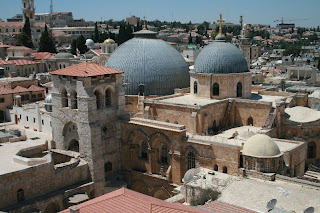Excuse the extra long post today, we made up for yesterday and saw quite a lot!

Here is a view back from the slopes of Mt Zion to our apartment, the roof terrace of which is just visible in the bottom right, near the tall tree.

Our first stop was the Church of the Dormition,
marking the place where Mary is believed to
have lived and 'fallen into eternal sleep' in the years after the resurrection.

Below the church, in the crypt, is a statue of Mary at which many pilgrims come to pray.

A short distance away is the Tomb of King David, a very simple synagogue, but one of the holiest places in Judaism.
Above this is the Crusader built Hall of the Last Supper (pictured), which some traditions say is the place where Jesus shared his last meal with the disciples, although there is another contesting site (see below). At present this very simple room is not used as a religious building although the Vatican is in negotiations to acquire it.

Our final stop on Mount Zion was the Church of St Peter in Gallicantu. The current church, like the Dormition, is modern but on the site of much older Byzantine ruins. St Peter's site is also on 1st Century remains which are probably the palace of Caiaphas, the High Priest at the time of the Crucifixion. Therefore the prison cells visible underneath St Peter's are thought to be where Jesus was taken after his arrest. The Church is therefore also associated with Peter's denial of Jesus as the cock crowed.

Also excavated at the site are the 1st Century steps leading from the Mount of Olives, via Caiaphas' house, to the old city. Jesus would have walked this way twice - once from the Last Supper to the Garden of Gethsemene and once from the Garden to the cells after his arrest.
For this reason these are known as the Sacred Steps and many people take their shoes off to walk them. Our feet however had taken enough punishment already.

We then walked into the old city via the Zion Gate. The marks all over this gate are bullet holes as it was once the front line between Jewish and Arab controlled regions.

Hidden, well hidden, in the maze of the Armenian Quarter is the Syrian Church of St Mark. Here an elderly lady called Justiana enthusiastically showed us round and told us stories. The Syrians claim that a room beneath the church (pictured), which is from Jesus' time, is in fact the house of St Mark's mother and is both the true site of the Last Supper and the room in which the disciples met at Pentecost. This would make it the very first Christian church. The Church also houses an icon they claim was painted by St Luke with the Vigrin Mary posing as a live model!

Further north is the Lutheran Church of the Redeemer, a 19th Century church which is of interest for its tower, seen on the left of this picture.

177 steps later the tower offers wonderful views across the whole area as far as the desert. Here we got our first chance to see the true shape of the Church of the Holy Sepulchure, since the narrow streets hide it mostly from view on the ground.

And here are the Church of Mary Magdalene and The Dome of the Rock viewed from the tower.

Finally we visited the Citadel. This fortress started its life in 200BC and was rebuilt, extended and lived in by each ruler of Jerusalem, particularly Herod the Great, Pontius Pilate, the Crusader Kings, Saladin and Suleyman the Magnificent. It is also where the British accepted the surrender of Jerusalem in 1917.
Tomorrow, we are going to explore the Dead Sea and desert regions.
No comments:
Post a Comment